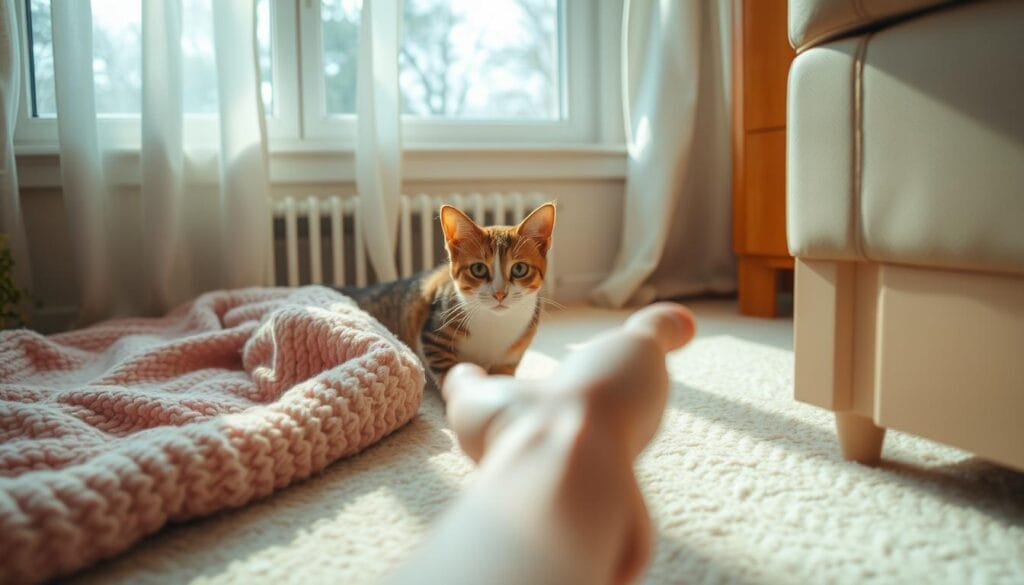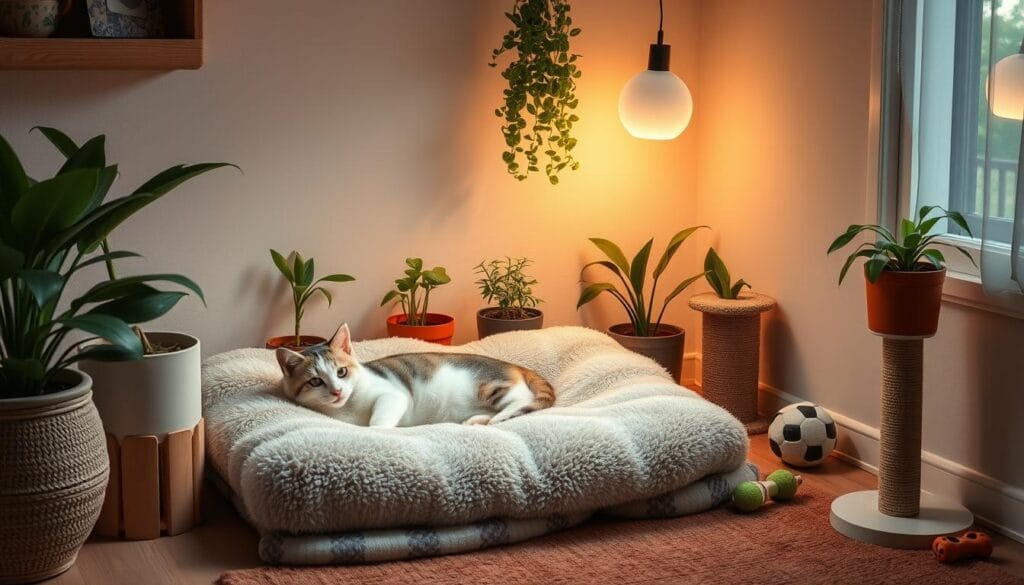(cat Trust) : Imagine your new cat, once full of energy, now hiding in fear. Building trust with a scared cat is a journey that needs patience and care. We’ll show you five key steps to make your cat feel safe and loved.

Key Takeaways
- Understand the common causes of cat fear and anxiety to better empathize with your pet’s experience.
- Create a safe and comfortable environment that helps your cat feel at ease in their new home.
- Learn to read and respond to your cat’s body language, using slow blinks and gentle movements to build trust.
- Establish positive associations through the strategic use of food and treats.
- Recognize the signs that your cat is beginning to trust you, and cherish the journey towards a lasting friendship.
Understanding Why Cats Become Fearful and Distrustful
Cats are complex creatures. Their fear and distrust come from many factors. To bond with a scared cat, knowing why they are anxious is key.
Common Causes of Cat Fear and Anxiety
Cats can fear and distrust for many reasons. Traumatic experiences, lack of socialization, and environmental changes are common. Sudden noises, new people or animals, and routine changes can also cause anxiety. (cat Trust)
How Past Experiences Shape Cat Behavior
A cat’s past greatly affects their behavior and trust. Cats that have been abused or neglected may not trust humans. But, cats with positive experiences and a stable home are more open to building a bond. (cat Trust)
Recognizing Signs of Fear in Cats
Knowing when a cat is scared is important. It helps you create a safe space and understand their body language. Look for dilated pupils, flattened ears, a tucked tail, and a tense posture.
| Sign of Fear | Description |
|---|---|
| Dilated Pupils | Cats’ pupils will become enlarged when they are feeling anxious or threatened. |
| Flattened Ears | A cat’s ears will be pressed flat against their head when they are afraid. |
| Tucked Tail | A fearful cat will tuck their tail close to their body, often between their legs. |
| Crouched Posture | Cats will crouch down low to the ground, making themselves appear smaller and less threatening. |
Understanding cat fear and anxiety is the first step. Knowing the signs helps you create a safe space for your cat. This way, you can build trust and a strong bond.

Creating a Safe and Comfortable Environment
Creating a safe and comfy space is key to building trust with a scared cat. A welcoming area can ease your cat’s anxiety and make them feel more at ease with you. This can lead to stronger pet bonding and animal-human relationships. (cat Trust)
Designating a “safe zone” in your home is a crucial step in building confidence with cats. This area should be quiet and low-traffic. Add your cat’s favorite bed, scratching post, and toys to make them feel more comfortable and at home. (cat Trust)
It’s also important to understand cat behavior and respect their need for space. Don’t force interactions or crowd your cat, as this can make them more anxious. Let them come to you and be patient as they learn to trust you. (cat Trust)
| Tips for Creating a Safe Environment | Benefits for Scared Cats |
|---|---|
| Designate a “safe zone” with familiar items Maintain a calm, quiet, and low-traffic area Avoid forcing interactions or crowding the cat Respect your cat’s personal space and let them approach you | Reduces anxiety and stress Encourages cats to feel more comfortable and secure Builds trust and strengthens the bond between cat and owner Helps cats feel in control and less threatened |
Creating a safe and comfy environment is the first step in building confidence with cats. With patience and understanding, you can help your cat overcome fears. This way, you can build a trusting and affectionate relationship.

Building Cat Trust Through Body Language and Patience
Building trust with a scared or shy cat takes time and understanding of cat behavior. Using your body language and movements can make a cat feel safe. By paying attention to the cat’s signals, you can build trust and create a strong bond. (cat Trust)
Reading and Responding to Cat Signals
Cats mainly talk through their body language. It’s important to learn these signals to build trust. Watch for the cat’s posture, ear position, tail, and eyes. A relaxed cat is more likely to feel safe, while sudden movements can scare it. (cat Trust)
The Power of Slow Blinking and Gentle Movements
Slow blinking is a great way to show a timid cat you’re calm. It tells the cat you’re not a threat. Adding gentle movements helps the cat feel more at ease and may encourage it to come closer. (cat Trust)
Maintaining Appropriate Distance
Respecting a cat’s space is key when building trust. Don’t crowd or corner the cat. Instead, let it come to you. Sit or lie down far away and wait for the cat to feel comfortable. Slowly get closer, but always watch for signs of stress. (cat Trust)
“The key to earning a cat’s trust is to let the cat set the pace and make the first move. With patience and an understanding of feline behavior, you can create a safe, welcoming environment that gradually earns the cat’s loyalty.” (cat Trust)

Establishing Positive Associations Through Food and Treats
Building trust with a scared cat needs patience and a gentle touch. Positive reinforcement, like linking food and treats to nice human moments, works well. This helps your cat feel better and bond with you more deeply.
Begin slowly and let your cat decide how fast to go. Give small, tasty treats by tossing them near your cat. Let them eat them when they’re ready. As they get used to it, you can get closer, even to hand-feeding. This makes your presence something they look forward to, not fear.
- Find out what treats your cat loves and use them to make good things happen.
- Move slowly and let your cat come to you, don’t push them.
- Be patient and keep doing it, building trust takes time and effort.
Positive reinforcement and a safe space help your scared cat learn to trust and enjoy your company. This trust is key to a strong pet-owner bond and a happy relationship with your cat.

| Positive Reinforcement Technique | Benefit |
|---|---|
| Offering Favorite Treats | Helps create positive associations with human presence |
| Gradual Approach and Interaction | Allows the cat to set the pace and feel in control |
| Patience and Consistency | Builds trust over time and reinforces the bond |
“The secret to building trust with a scared cat is to go at their pace and make every interaction a positive experience.”
The Essential Role of Cat Trust in Building Lasting Bonds
Building a trusting relationship with your cat is key to a fulfilling bond. Understanding cat communication and animal behavior is vital in building trust with cats. But how do you know if your cat trusts you, and how to keep that trust?
Signs Your Cat is Beginning to Trust You
When your cat starts to trust you, they show it in many ways. They might make eye contact, blink slowly, or even come to you for pets. If they feel safe, they’ll spend more time with you, whether sleeping or playing.
Progressing from Fear to Friendship
Changing a fearful, distrustful cat into a loving friend takes time. Keep providing a safe, comfortable environment and listen to their signals. As they get to know you, they’ll learn to trust your presence and see you as a source of comfort.
Maintaining Trust Long-Term
To keep your cat’s trust, you must always understand their needs and emotions. Respect their space, be consistent, and always be gentle. This will grow a lasting, meaningful bond that makes both your lives better.
Having a trusting relationship with your cat brings endless joy. By meeting their unique needs and understanding their way of communicating, you create a bond that will bring happiness for many years.
Conclusion
To build trust with a scared cat, you need patience, understanding, and effort. Start by making a safe and comfy space for them. Also, learn and act on their signals, and use treats to make good memories.
Every cat is different, so trust-building takes time. Always respect their space and watch their body language. Let them decide how fast to move forward. With patience, you can help your cat feel safe and build a strong bond.
Using the tips from this article will help you understand your cat better. It will also help you build their confidence and respect their boundaries. This journey is rewarding, and it will make your cat’s companionship even more special.
FAQ
How do I know if my cat trusts me?
Signs your cat trusts you include slow blinking and purring. They might knead or seek your affection. If they approach you and relax, it’s a good sign.
Why doesn’t my stray cat trust me?
Stray cats often fear humans due to past bad experiences. It’s normal for them to be cautious. Be patient and respect their space as you build trust.
What are the signs a feral cat trusts you?
If a feral cat looks at you more, comes for food, or lets you get closer, it’s a good sign. They might even seek you out and feel comfortable with your touch.
How can I get a feral cat to trust me?
Building trust with a feral cat takes time and patience. Create a calm space, offer food, and slowly get closer. Be gentle and quiet, and the cat will start to trust you.
How do I get a stray cat to trust me?
Start by giving a stray cat a safe place and food. Sit near them and let them come to you. Use treats to make your presence positive.
Why don’t I trust cats?
You might not trust cats if you’ve had bad experiences or prefer other pets. Remember, every cat is different. With patience, you can build trust and a good relationship with a cat.
IMPORTANT ADDITIONS
Edited on , 10 DEC ,2024
Read more articles : https://petsfeeling.com/blog-2/
social media :
facebook : https://www.facebook.com/PetsFeeling0/
tiktok : https://www.tiktok.com/@pets.feeling
instagram : https://www.instagram.com/pets._.feeling/
youtube : https://www.youtube.com/@Pets-Feeling

